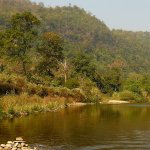Thung Yai-Huai Kha Khaeng Wildlife Sanctuaries Day in Thailand Date in the current year: September 9, 2026
 Thung Yai-Huai Kha Khaeng Wildlife Sanctuaries Day in Thailand is observed on September 9. It was officially established in 1995 to celebrate two adjoining wildlife sanctuaries, Hua Kha Khaeng and Thung Yai Naresuan, that were declared a UNESCO World Heritage Site in 1991.
Thung Yai-Huai Kha Khaeng Wildlife Sanctuaries Day in Thailand is observed on September 9. It was officially established in 1995 to celebrate two adjoining wildlife sanctuaries, Hua Kha Khaeng and Thung Yai Naresuan, that were declared a UNESCO World Heritage Site in 1991.The Thung Yai-Huai Kha Khaeng Wildlife Sanctuaries are located in Kanchanaburi, Tak and Uthai Thani provinces in western Thailand. The Huai Kha Khaeng Wildlife Sanctuary was officially established in September 1972. It originally covered the area of 163,100 hectares and has since been expanded twice. Its current total area is 278,000 hectares. The Thung Yai Naresuan Wildlife Sanctuary was established in April 1974 and currently covers the area of 364,000 hectares.
After the establishment of Huai Kha Khaeng, several Karen villages were located within the sanctuary. However, they were moved to Ban Rai District of Uthani Thani Province in 1976. A Hmong village was relocated from the sanctuary in 1986. Today, Huai Kha Khaeng has no human population, but there are several Karen villages left in Thung Yai.
In 1991, Huai Kha Khaeng and Thung Yai were jointly declared a World Heritage Site by UNESCO because of their significant biodiversity; the two sanctuaries contain examples of most forest types found in Mainland Southeast Asia and are home to rare, endangered and endemic species from four biogeographic regions of Southeast Asia: Sundaland, Indo-China, Indo-Burma, and the Sino-Himalayan region.
According to the UNESCO official website, the sanctuaries are home to 77% of the large mammals (especially tigers and elephants), 50% of the large birds and 33% of the land vertebrates that are found in the region. More specifically, this includes 120 mammals, 400 birds, 96 reptiles, 43 amphibians, and 113 fish. However, this list may be incomplete, because research on the sanctuaries’ biodiversity is sparse.
Among the species living in Hua Kha Khaeng and Thung Yai are Asian black bear, Asian buffalo, clouded leopard, Fea’s muntjac, gaur, hog deer, Indian elephant, Indochinese leopard, Indochinese tiger, lar gibbon, Malayan tapir, sambar, Sumatran serow, sun bear, various species of lutung and macaque, and several bat species (including Kitti’s hog-nosed bat, which is the smallest bat species and arguably the smallest mammal in the world).
Huai Kha Khaeng is open to visitors, most of whom come during the dry season or the summer. Visitors are required to pay an entrance fee, which is ten times higher for foreign tourists than for locals. Some sections of the sanctuary are closed for the general public; to access them, one needs to obtain a permission from the Conservation Office in Bangkok. Such permissions are usually granted to researchers, students, and the like.
Thung Yai-Huai Kha Khaeng Wildlife Sanctuaries Day was established to highlight the importance of the sanctuaries as a conservation area, which lies in the diversity of their flora and fauna, the integrity and heterogeneity of their habitats, and the complexity of their ecosystem.
- Category
- Ecological Observances
- Country
- Thailand
- Tags
- Thung Yai-Huai Kha Khaeng Wildlife Sanctuaries Day in Thailand, ecological observances, holidays in Thailand, World Heritage Site